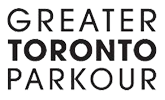About

Mission Statement
Helping people be healthy
For our community, our city and our team
We do this through a culture of action, community involvement, and environmental awareness
We teach Parkour. Want to learn how?
Background
“Être fort pour être utile” – Be strong to be useful
Parkour, L’Art du Déplacement, Freerunning….
Whatever name the activity, the art of moving involves three fundamental skills – running, jumping, climbing and vaulting – in all their variants.
Parkour is a physical discipline that is focused on efficiently and effectively passing obstacles, relying only on one’s body using the three fundamental skills.
Practitioners train physically and mentally to move about their environment, creating their own imperative on why to leave one place and to reach another.
As such, in the mind of a practitioner, obstacles are used to create opportunities.
Parkour itself is scalable to one’s one physical and mental abilities. At the beginning, basic movements and physical ability will need to be developed. As progress is made, so too will one’s abilities and goals.
The Benefits of Parkour
It is a complete training method where one combines strength, endurance, coordination, agility, balance and sense of creativity.
It is also relevant to the values of the world: it promotes courage and perseverance, self-awareness, respect for others, and caring for one’s community.
Mental abilities are also enhanced including problem-solving skills, calmness under-pressure, confidence, risk management and judgment.
What is the appeal?
- It’s fun to move around freely.
- It’s adaptable to all skill levels.
- Some Parkour related skills are admired due to media (YouTube, Assassin’s Creed, Cirque du Soleil, etc..)
- Not competitive by nature: individuals measure their own success to themselves, not others.
Parkour Session Principles
Parkour can be seen as a philosophy of movement practice and has with it many unofficial principles which many Parkour communities abide by, one of which is “être et durer” (to be and to last). Participants should be better off from training; they should feel energetic and positive about going about their lives.
Based on this:
- Training is done so that we can be functional today and tomorrow.
- Safety is always the first priority!
- Training is done at one’s own level and progression.
- Inclusiveness of all participants. Nobody gets better unless we all help each other. To diminish one of us is to diminish us all.
- Participants are encouraged to take breaks and drink water whenever they want or need it.
Parkour Program Session Framework
Below is the framework for a typical session:
- A Dynamic and Movement based Warm-up
- Skills Development
- Progression for specific movements such as vaulting, wall running, precision jumping
- Progression allows for absolute beginners to advanced practitioners to participate, have fun and be challenged.
- Game/Course/Circuit
- Links many of the skills previously practiced
- Based on increasing speed, stealth, acceleration and stopping and other physical development
- Physical Conditioning
- Physical strength, speed and endurance developed from bodyweight and calisthenics exercises
- Cool down, clean up, and reflection
- Clean up and put away equipment and any garbage
- Lower body temperature to normal and stretch to relax muscles
- If anyone has any questions or feedback, they are encouraged to provide it.
Misconceptions of Parkour
There exists many misconceptions of Parkour and, for us, it’s important our views are clear and honest for everyone so that we can continue to grow in positive ways.
Parkour is not a martial art
There are no forms or codified practices and traditions related to combat. There is no combat. As such, Parkour is not a martial art.
Parkour is not a sport
Parkour isn’t about competition, there are no teams or individuals competing against each other and it’s not done for the amusement of others. We challenge ourselves and work with others to grow. We start together, we finish together.
Parkour is not dangerous
One does not learn to run before they know how to crawl.
Baby ducks don’t jump off the top of buildings before testing their wings on the ground.
When meeting practitioners of sports and martial arts who carry incapacitating injuries one is justified in questioning exactly how effective their training is. Their training has, in effect, produced the very results they were trying so hard to avoid.
The goal of Parkour then is to be effective and efficient in moving one’s body to reach a targeted area. Why risk injury so that one can’t do what they train to do?
Participant Age Group
The City of Toronto has been running a Parkour program for youth ages 13-24. This has been for over 81 sessions, over 160 hours for a total of 3 years. From our understanding over this course of time, there have been minimal incident reports in comparison to other programs of such a physical nature (basketball, gymnastics, etc.).
With such programming, there should be little or no barrier to entry and should be inclusive of all ages. Similar programs have been run in the UK and France for youth-at-risk (Please refer to Natural Born Heroes for the UK, and Generation Yamakasi documentary for more information).

